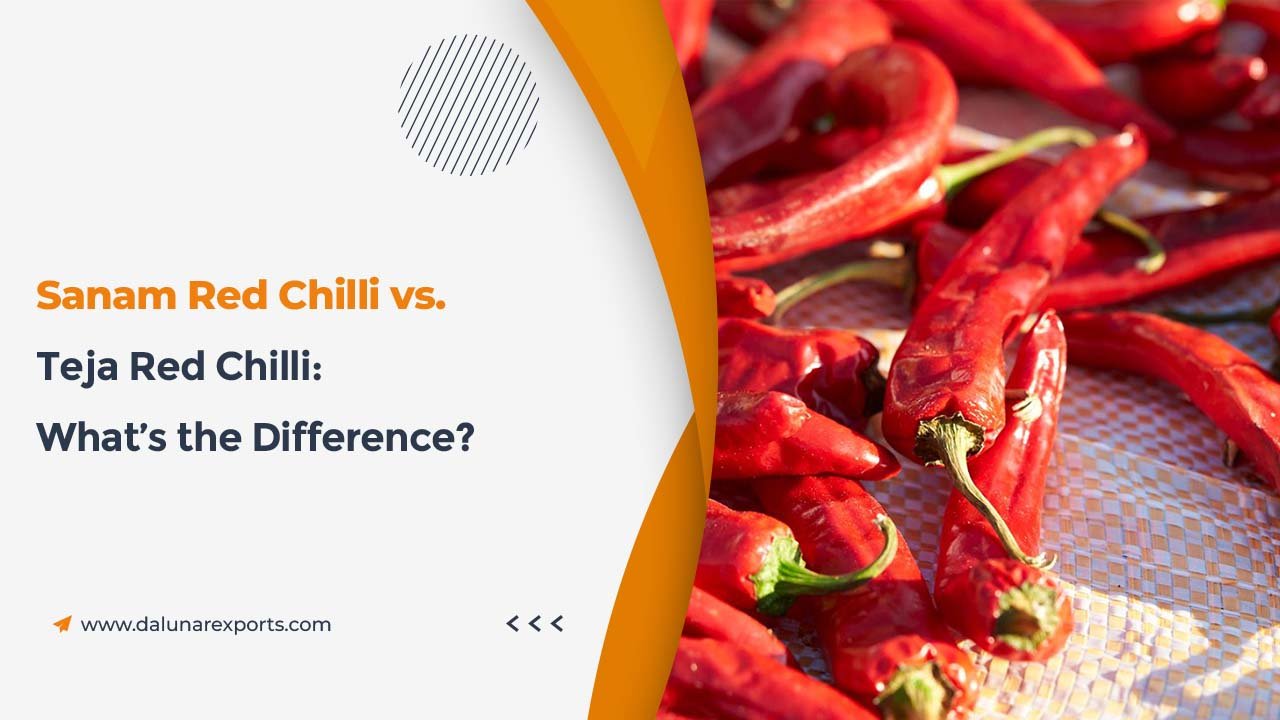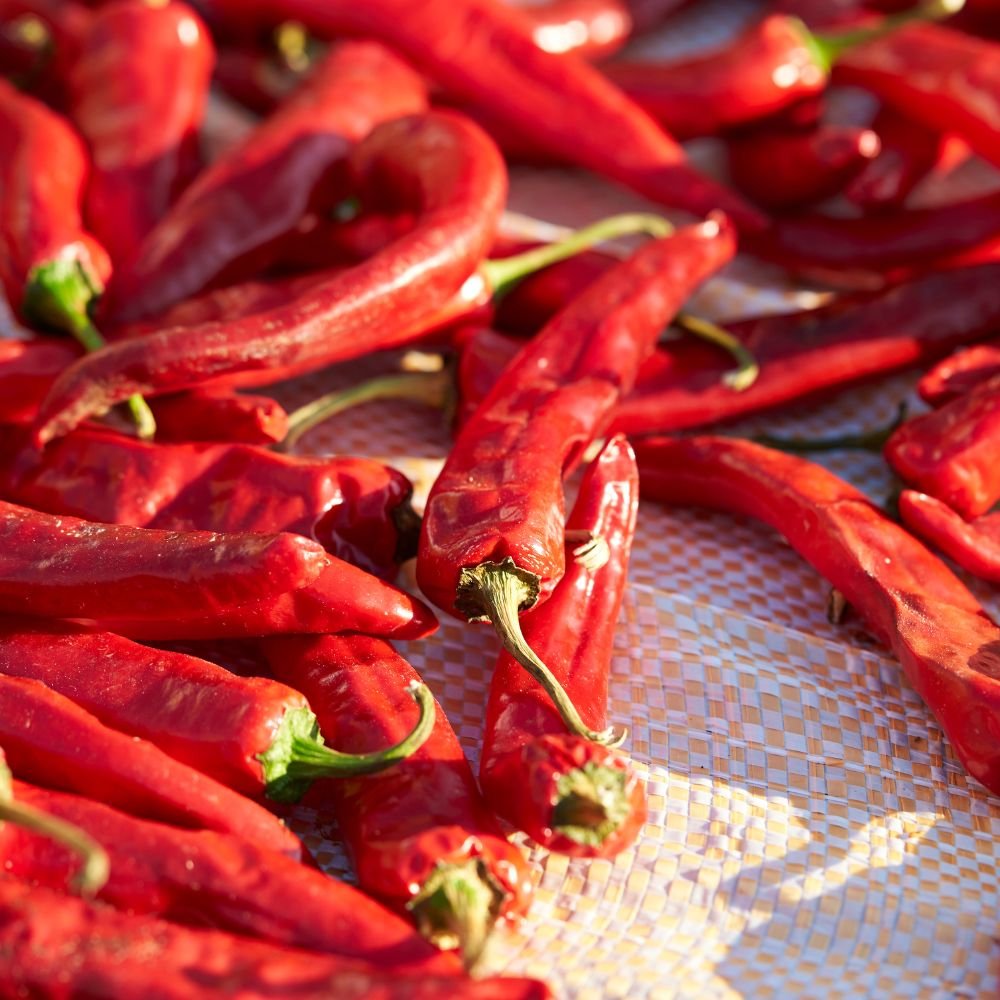
Sanam Red Chilli vs. Teja Red Chilli: What’s the Difference?
Red chilies are among the most important ingredients in kitchens worldwide, and India is known for its spices and flavors. In this article, we will learn the differences between Teja and Sanam Red Chilies, two of the most widely consumed types of chilies. Both are commonly grown in India and are much sought after in international markets, yet they differ in specific ways that set them apart. Today, we examine their distinctions from farm to table and the reasons behind their popularity in home and foreign cooking.
Spices give food taste and color and have economic, medical, and cultural value. India’s rich agricultural legacy and varied culinary traditions are exemplified by its red chilies, especially the Sanam and Teja types. In this blog, we examine what makes these premium chili varietals unique, which Dalunar Exports is happy to offer to a global audience.
Differences Between Sanam Red Chilli and Teja Red Chilli
Origin and Cultivation Region
The lush grounds of the Guntur district in Andhra Pradesh are the source of Sanam red chilies, also known as Guntur Sannam. Farmers who have mastered the technique of producing premium chilies with the ideal ratio of heat to aroma have traditionally grown these chillies. Guntur’s hot, muggy, and sun-drenched climate makes it the perfect place to grow Sanam chilies, which produce medium-sized, bright red chillies with a unique scent.
Teja red chilies, also known as Teja S17, are mostly farmed in Andhra Pradesh and some regions of Telangana. They are grown to increase their intensity and pungency. This kind is used in recipes that call for a burst of heat because it has been bred for a stronger heat profile. To maintain their strong flavor and pungency, the growing methods frequently emphasize timing accuracy, especially during harvesting and drying.

Physical and Chemical Properties
Sanam Red Chilli
- Usually modest in length (about 5 to 8 cm).
- Has a slim, slightly curved design and a vivid, appealing red color.
- Because of its relative thinness, the skin naturally dries out in the sun.
- Usually, the SHU is between 25,000 and 35,000 SHU, which is in the middle of the Scoville scale.
- Provides a well-balanced amount of heat that brings out the flavor without overwhelming the meal.
- Includes a moderate amount of capsaicin, which offers health advantages like improving digestion and metabolism and adding heat.
Teja Red Chilli
- Though they seem more sturdy, they are frequently comparable in size.
- Distinguished by a more constant, homogeneous shape and a rich, vivid red hue.
- The somewhat thicker skin offers more protection while being processed and transported.
- Renowned for having more pungency and frequently receiving higher Scoville scores.
- Teja chiles have a fiercer, more intense heat because of their higher concentration of capsaicin.
- Because of their strength, they are particularly well-suited to robust curries, hot sauces, and spicy pickles that need a little more zing.
Culinary Uses and Flavor Differences
Sanam Red Chilli
Sanam red chilies are a mainstay in many traditional Indian cuisines because of their pleasing hue and well-balanced spiciness. Because of their adaptability can be ground into a fine powder, dried, or utilized whole. Among the typical applications are:
- Use in curries and stews to get that warm and smoky flavor without overwhelming other spices.
- For chutneys and sauces to get that moderate heat.
- For the preparation of pickles and their preservation
Teja Red Chilli Powder
Teja red chillies are renowned for their potent heat, which makes them an essential ingredient for anyone who wants their food to have a slight spiciness. Among their uses are:
- For spicy curries and gravies to get assertive heat and make it into a spicy delight
- For preparing hot sauces to get that pack of punch and pungent flavors
- To make marinades and spicy blends in meat and fish preparations.
Economic and Export Significance
Teja and Sanam red chillies are important to India’s spice export business. According to recent economic assessments,
Sanam Red Chilli
Sanam Red Chillies provide greater net yields per acre at reduced cultivation costs. According to a comparative study conducted in the Guntur region, farmers that grow Sanam chillies typically experience higher profitability because of lower input costs and higher market prices.
Teja Red Chilli
On the other hand, Teja Red Chillies command premium pricing in foreign markets because of their potent heat and distinctive flavor profile, even though their cultivation costs are slightly higher. As a result of their superior market placement, exporters are more profitable.
Dalunar Exports, the leading exporter of sanam red chilies, takes advantage of this financial opportunity by ensuring that each shipment meets exacting quality requirements. These chillies are adaptable items with a wide range of export appeal, as they can satisfy the fiery demand in some cuisines and the moderate heat preference in others.
Health Benefits
Indian red chilies offer a wealth of health advantages in addition to being a great way to add heat:
- The key ingredient in chillies, capsaicin, has been connected to better digestion, accelerated metabolism, and even pain relief.
- Antioxidant Properties: Packed with antioxidants, both types aid in scavenging dangerous free radicals.
- Nutritional Value: They support a healthy immune system because they are also an excellent source of vitamins A and C.
Teja and Sanam chilies share these advantages. However, the choice of cultivar may depend on the desired level of capsaicin for health benefits, flavor, and culinary use.
Quality Assurance and Processing
The entire process from farm to export is very organized and sorted, involving many quality control checks. The process can be divided into the three parts below:
Harvesting & Sorting: Both chilies are hand-picked and sorted to get rid of broken or underdeveloped pods.
The drying process: Natural sun-drying is a popular technique for maintaining Sanam chilies’ natural color and flavor. Because of their sturdy structure, Teja chilies are occasionally dried using regulated methods to guarantee uniformity.
Packaging and Grading: The chillies are packaged for export after being dried and sorted according to size, color, and pungency. To ensure that only the highest quality items are sent to our clients worldwide, Dalunar Exports rigorously tests every batch to satisfy international standards.
Choosing the Right Chilli Powder
Choosing between Teja and Sanam red chiles frequently boils down to the intended culinary use:
- Sanam red chilies are the best option for recipes that require well-balanced heat and a focus on color and scent.
- Teja red chilies work well in recipes that require a strong, scorching kick. Because of their concentrated heat, which can dramatically increase the amount of spice in a recipe, they are ideal for hot sauces, spicy pickles, and hearty curries.
Conclusion
In conclusion, Teja and Sanam red chillies each have unique characteristics that make them essential in the kitchen:
- Sanam Red Chillies add remarkable color and aroma, along with a medium-balanced heat that makes them suitable for a variety of recipes.
- Teja Red Chillies are different and diverse by their potent spiciness and intense flavor, making them perfect for recipes that call for more heat.
At Dalunar Exports, we’re dedicated to providing our global customers with the best spices available. Our committed quality assurance and processing facilities guarantee that you receive products that satisfy the highest standards of excellence, whether you prefer the fiery punch of Teja red chilies or the well-balanced appeal of Sanam red chilies. Please contact us or browse our website for additional details on our red chilli exports.
Tag Here

